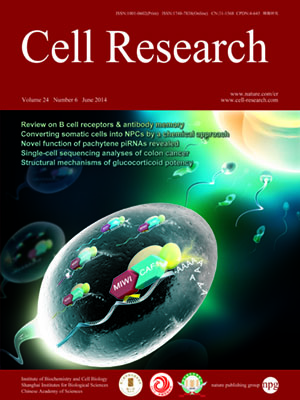
Volume 24, No 6, Jun 2014
ISSN: 1001-0602
EISSN: 1748-7838 2018
impact factor 17.848*
(Clarivate Analytics, 2019)
Volume 24 Issue 6, June 2014: 680-700 | Open Access
ORIGINAL ARTICLES
Pachytene piRNAs instruct massive mRNA elimination during late spermiogenesis
Lan-Tao Gou1,2,*, Peng Dai1,2,*, Jian-Hua Yang3,*, Yuanchao Xue4, Yun-Ping Hu1,2, Yu Zhou4, Jun-Yan Kang1,2, Xin Wang1,2, Hairi Li4, Min-Min Hua1,2, Shuang Zhao1,2, Si-Da Hu1,2, Li-Gang Wu1,2, Hui-Juan Shi5, Yong Li6, Xiang-Dong Fu4, Liang-Hu Qu3, En-Duo Wang1 and Mo-Fang Liu1,2
1Center for RNA Research, State Key Laboratory of Molecular Biology–University of Chinese Academy of Sciences, Shanghai 200031, China
2Shanghai Key Laboratory of Molecular Andrology, Institute of Biochemistry and Cell Biology, Shanghai Institutes for Biological Sciences, Chinese Academy of Sciences, Shanghai 200031, China
3Key Laboratory of Gene Engineering of the Ministry of Education, State Key Laboratory of Biocontrol, Sun Yat-sen University, Guangzhou 510275, China
4Department of Cellular and Molecular Medicine, University of California, San Diego, La Jolla, CA 92093-0651, USA
5National Population and Family Planning Committee Key Laboratory of Contraceptive Drugs & Devices, Shanghai Institute of Planned Parenthood Research, Shanghai 200032, China
6Department of Biochemistry and Molecular Biology and Center for Genetics and Molecular Medicine, School of Medicine, University of Louisville, Louisville, KY 40202, US
Correspondence: Mo-Fang Liu, Tel: 86 21 54921146; Fax: 86 21 54921011(mfliu@sibcb.ac.cn)
Spermatogenesis in mammals is characterized by two waves of piRNA expression: one corresponds to classic piRNAs responsible for silencing retrotransponsons and the second wave is predominantly derived from nontransposon intergenic regions in pachytene spermatocytes, but the function of these pachytene piRNAs is largely unknown. Here, we report the involvement of pachytene piRNAs in instructing massive mRNA elimination in mouse elongating spermatids (ES). We demonstrate that a piRNA-induced silencing complex (pi-RISC) containing murine PIWI (MIWI) and deadenylase CAF1 is selectively assembled in ES, which is responsible for inducing mRNA deadenylation and decay via a mechanism that resembles the action of miRNAs in somatic cells. Such a highly orchestrated program appears to take full advantage of the enormous repertoire of diversified targeting capacity of pachytene piRNAs derived from nontransposon intergenic regions. These findings suggest that pachytene piRNAs are responsible for inactivating vast cellular programs in preparation for sperm production from ES.
10.1038/cr.2014.41
FULL TEXT | PDF
Browse 2637


